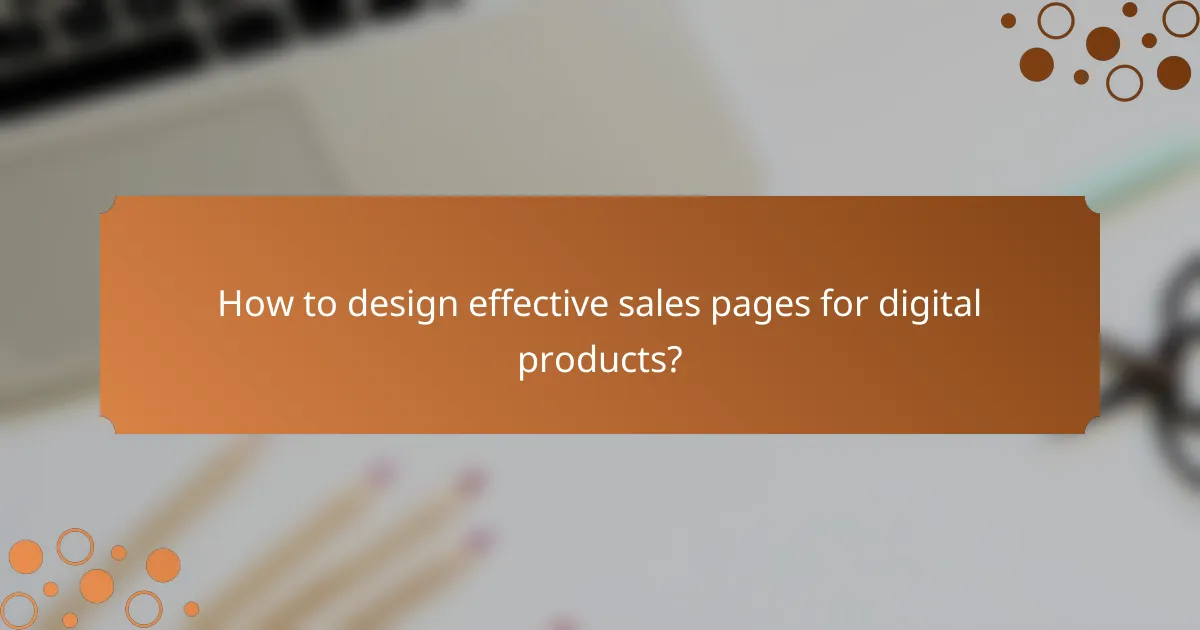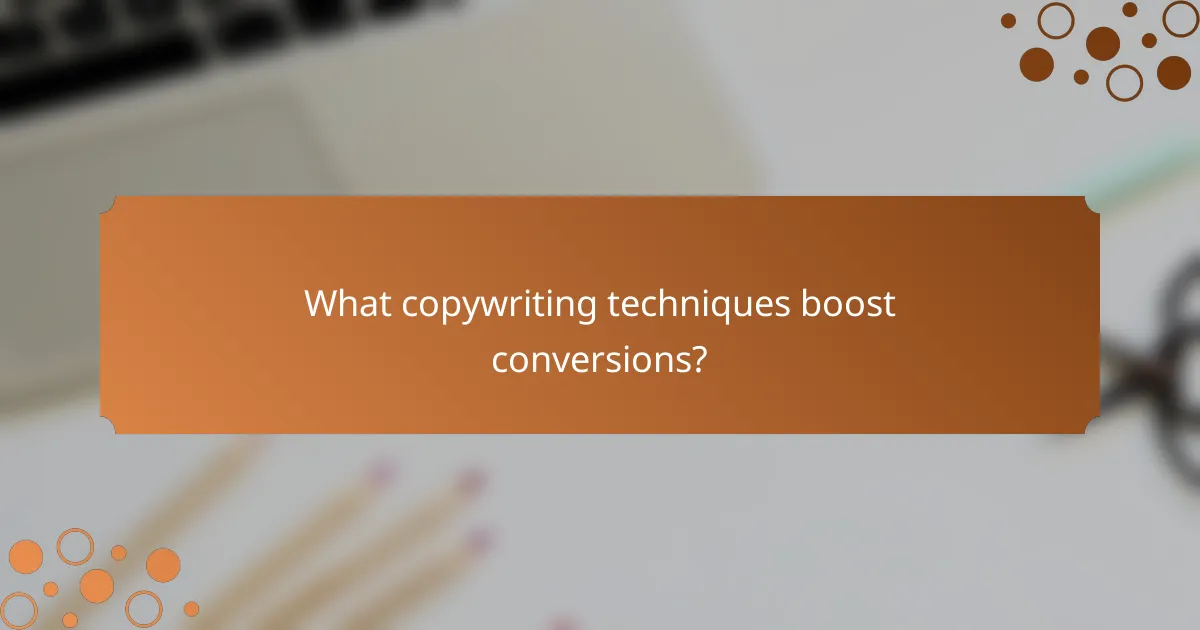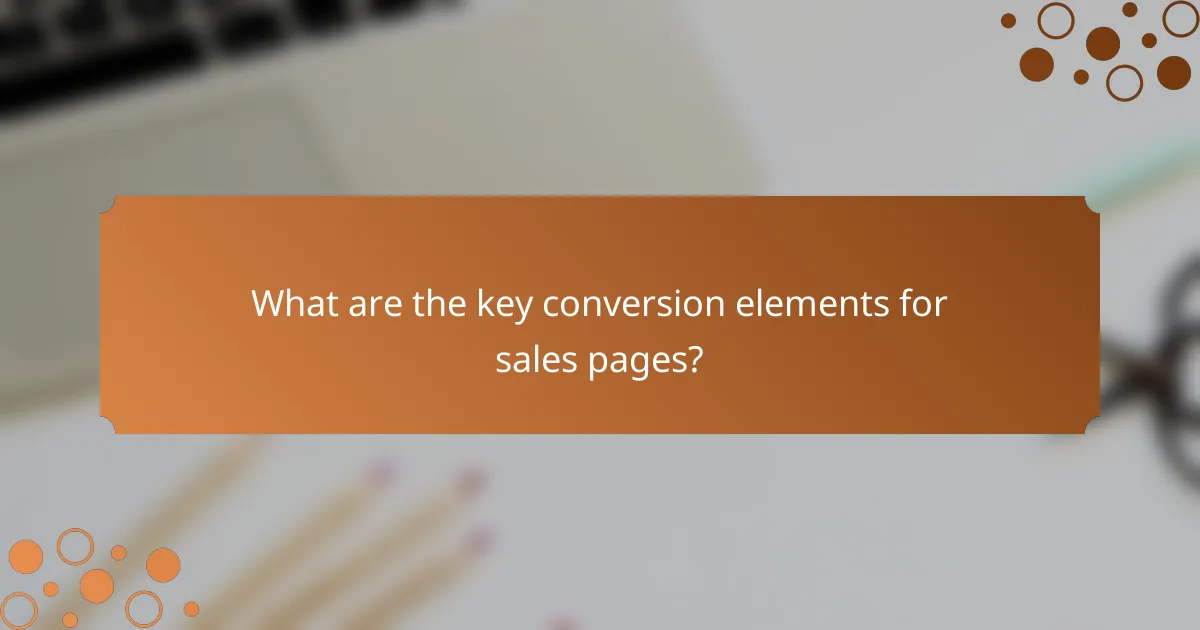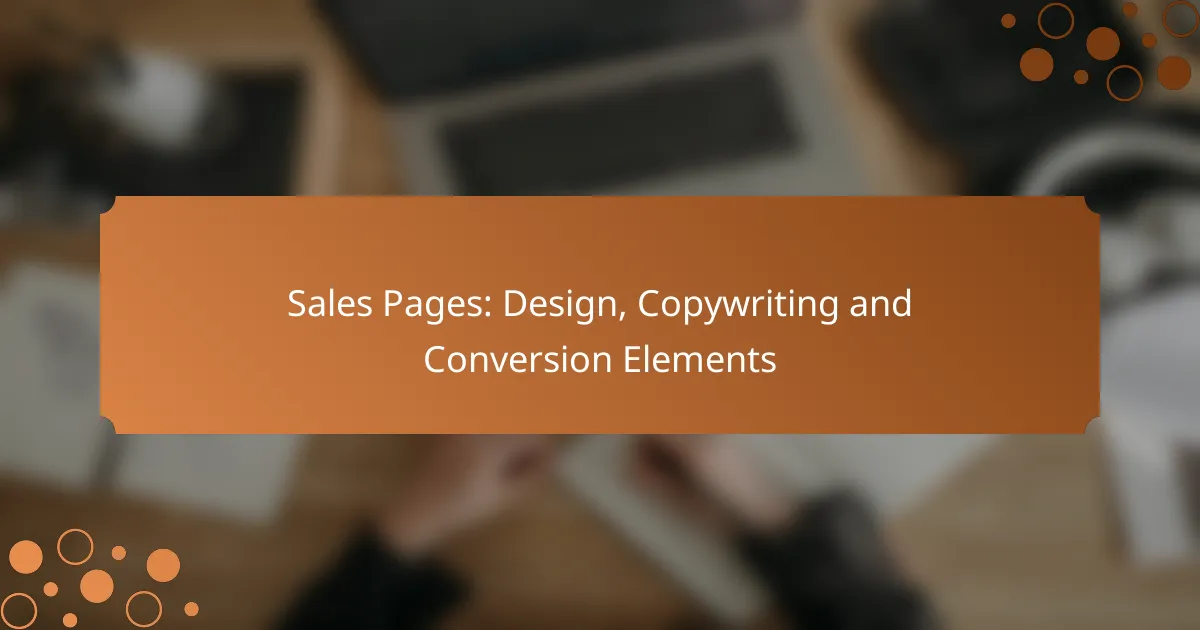Creating an effective sales page for digital products requires a strategic blend of clear communication, persuasive design, and user-friendly layouts. By focusing on impactful copywriting techniques and essential conversion elements, you can significantly boost your sales and engage potential customers more effectively. Incorporating trust signals, urgency tactics, and strong calls to action will further enhance your page’s ability to convert visitors into buyers.

How to design effective sales pages for digital products?
Effective sales pages for digital products focus on clear communication, persuasive design, and user-friendly layouts. Prioritizing these elements can significantly enhance conversion rates and drive sales.
Visual hierarchy and layout
Visual hierarchy guides users through the content by emphasizing the most important elements. Use larger fonts for headlines, contrasting colors for calls to action, and ample white space to create a clean layout that directs attention.
Consider using a grid system to align elements consistently. This approach helps users navigate the page intuitively, making it easier for them to find information and take action.
Responsive design principles
Responsive design ensures that sales pages function well on various devices, from desktops to smartphones. This adaptability is crucial since many users browse on mobile devices, and a poor experience can lead to lost sales.
Utilize flexible grids and images, along with media queries, to adjust layouts based on screen size. Test your sales page on multiple devices to ensure a seamless user experience across all platforms.
Use of color psychology
Color psychology plays a vital role in influencing user emotions and behaviors. For instance, blue often conveys trust, while red can create urgency. Choose colors that align with your brand and evoke the desired response from potential customers.
Limit your color palette to a few complementary shades to maintain visual coherence. Use contrasting colors for buttons and key messages to make them stand out and encourage action.
Incorporating multimedia elements
Multimedia elements, such as videos and images, can enhance engagement and convey information more effectively than text alone. A well-placed product video can demonstrate features and benefits, increasing the likelihood of conversion.
Ensure that multimedia content is optimized for fast loading times. Use formats that balance quality and file size, and consider including captions for accessibility and improved SEO.
Examples from successful brands
Analyzing successful sales pages can provide valuable insights into effective design and copywriting strategies. Brands like Apple and Shopify use clean layouts, strong visuals, and concise messaging to drive conversions.
Look for common elements in these examples, such as clear calls to action, testimonials, and a focus on user benefits. Implementing similar strategies can help improve your own sales page’s effectiveness.

What copywriting techniques boost conversions?
Effective copywriting techniques can significantly enhance conversions by engaging potential customers and guiding them toward making a purchase. Key strategies include crafting compelling headlines, utilizing storytelling, implementing strong calls to action, addressing customer pain points, and leveraging social proof.
Crafting compelling headlines
Compelling headlines grab attention and encourage readers to explore further. A strong headline should be clear, concise, and convey the main benefit or unique selling proposition of the product or service. Aim for headlines that evoke curiosity or urgency, such as “Unlock Your Potential Today!” or “Limited Time Offer: Save 50%!”
Consider using numbers or questions in your headlines to increase engagement. For instance, “5 Ways to Improve Your Productivity” or “Are You Ready to Transform Your Life?” can draw readers in and make them want to learn more.
Utilizing storytelling methods
Storytelling creates emotional connections with your audience, making your message more relatable and memorable. By sharing a narrative that highlights how your product or service has positively impacted others, you can foster trust and interest. For example, a customer success story can illustrate the transformation your offering provides.
When crafting your story, focus on characters, challenges, and resolutions. This structure helps potential customers envision themselves in similar situations and see how your solution can help them overcome their own challenges.
Effective call-to-action strategies
A strong call to action (CTA) is crucial for guiding customers toward conversion. Your CTA should be clear, direct, and action-oriented, using phrases like “Buy Now,” “Get Started,” or “Sign Up Today.” Position your CTA prominently on the page to ensure it stands out.
Experiment with different colors, sizes, and placements for your CTA buttons to determine what resonates best with your audience. A/B testing can help identify the most effective variations, leading to higher conversion rates.
Addressing customer pain points
Understanding and addressing customer pain points is essential for effective copywriting. Identify the specific problems your target audience faces and clearly communicate how your product or service provides a solution. This approach demonstrates empathy and positions your offering as a necessary tool for improvement.
Use language that resonates with your audience’s experiences. Phrases like “Tired of struggling with X?” or “Say goodbye to Y” can create a sense of urgency and motivate potential customers to take action.
Social proof and testimonials
Social proof, such as testimonials and reviews, can significantly influence purchasing decisions. Displaying positive feedback from satisfied customers builds credibility and trust, encouraging new visitors to convert. Incorporate quotes, star ratings, or video testimonials to showcase real experiences.
When presenting testimonials, highlight specific benefits or results that customers have achieved. This not only validates your claims but also helps potential buyers envision their own success with your product or service.

What are the key conversion elements for sales pages?
The key conversion elements for sales pages include trust signals, optimized forms, urgency tactics, and user behavior analysis. Each element plays a crucial role in persuading visitors to take action, such as making a purchase or signing up for a newsletter.
Importance of trust signals
Trust signals are essential for establishing credibility and reassuring potential customers. These can include customer testimonials, reviews, security badges, and money-back guarantees. Incorporating these elements can significantly enhance the perceived reliability of your sales page.
For example, displaying recognizable payment options and showcasing user ratings can help alleviate concerns about security and quality. Aim to include at least three different types of trust signals to maximize their effectiveness.
Optimizing forms and checkout processes
Streamlined forms and checkout processes are vital for reducing friction during the purchasing journey. Keep forms short and only request necessary information to avoid overwhelming users. Consider using autofill options and progress indicators to enhance user experience.
For checkout, ensure that the process is clear and straightforward, ideally taking no more than a few minutes. Offering multiple payment methods can also cater to different user preferences, increasing the likelihood of conversion.
Implementing urgency and scarcity tactics
Urgency and scarcity tactics create a sense of immediacy that can drive conversions. This can be achieved through limited-time offers, countdown timers, or low-stock notifications. These strategies encourage users to act quickly rather than delaying their decision.
For instance, displaying a message like “Only 3 items left in stock!” can prompt users to complete their purchase. However, use these tactics ethically to maintain trust and avoid backlash from customers.
Analyzing user behavior and feedback
Regularly analyzing user behavior and feedback is crucial for optimizing sales pages. Tools like heatmaps and analytics can reveal how visitors interact with your page, helping identify areas for improvement. Pay attention to metrics such as bounce rates and conversion rates to gauge effectiveness.
Additionally, soliciting direct feedback through surveys can provide insights into user preferences and pain points. Implementing changes based on this data can lead to higher engagement and better conversion rates over time.

What frameworks help in evaluating sales page effectiveness?
Evaluating sales page effectiveness involves using frameworks that focus on key performance indicators and testing methodologies. These frameworks help identify strengths and weaknesses in design and copy, ultimately driving better conversion rates.
Conversion rate optimization metrics
Conversion rate optimization (CRO) metrics are essential for assessing how well a sales page converts visitors into customers. Key metrics include conversion rate, bounce rate, average order value, and customer lifetime value. Tracking these metrics allows you to pinpoint areas needing improvement.
For instance, a typical conversion rate for e-commerce sites ranges from 1% to 3%. If your page falls below this range, it may indicate issues with the design or messaging that need addressing. Regularly analyzing these metrics can lead to actionable insights that enhance overall performance.
A/B testing methodologies
A/B testing is a powerful methodology for evaluating sales page effectiveness by comparing two versions of a page to determine which performs better. This involves changing one element at a time, such as headlines, images, or call-to-action buttons, and measuring the impact on conversion rates.
When conducting A/B tests, ensure that you have a sufficient sample size to achieve statistically significant results. Aim for a testing duration of at least one to two weeks to account for variations in visitor behavior. Common pitfalls include testing too many changes at once or running tests for too short a period, which can lead to inconclusive results.
